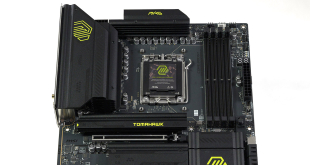The P8P67 Deluxe uses the Unified Extensible Firmware Interface to provide a very user friendly and intuitive interface for tweaking and customising settings. We really do find the new bioses much nicer to work with and the mouse support is a welcome addition.
The only slightly confusing interface design decision is to position the really important settings within an ‘exit/advanced mode' button top right of the initial interface.
Upon first boot, ASUS position the user firmly within the ‘EZ mode' interface. This is a cut down front end to keep everything as simple and straightforward as possible. Temperatures and fan speeds are also indicated.
By simply clicking a few brightly coloured on screen icons, the user can load pre-defined settings. Power saving, normal and optimal. At the bottom of the screen is a very handy ‘boot priority' section which means that users can change the boot priority by simply dragging and dropping icons. For veterans of the ‘blue' bios screens, it all just seems too easy to be true. We recommend that you set the bios to advanced mode however by default. This is where all the really tasty settings are configured.
The main page of the interface is nicely laid out with commonly required bios features all grouped into six main categories. Main, AI Tweaker, Advanced, Monitor, Boot and Tool. We will leave the AI Tweaker panel to last.
The Advanced panel gives access to many of the boards integrated hardware features across various sub menus, including CPU configuration, SATA configuration and Onboard devices configuration.
CPU configuration highlights many of the processors key specifications and lets the user adjust settings such as Turbo Mode and Speedstep.
The monitor tab is self explanatory, offering a list of temperatures and voltage settings. It also allows for control over CPU and chassis fans.
The boot menu tab offers settings to configure hard drives, and to work with removable drives when needed. The tool menu gives easy access to specific functionality, such as when needing to update the bios to newer code.
The automatic bios overclocking settings work surprisingly well, and the board configured the Intel Core i7 2600k to 4.3ghz at the flick of a switch. The voltage settings were not increased.
Manually we were able to achieve 4.8ghz with core voltage increases to 1.48. The system was completely stable at this speed, with temperatures held in place by the Thermaltake Frio OCK. Achieving 4.8ghz with a 2600k is very easy and we have covered it before in other reviews. With this specific motherboard I found it simply a matter of changing a few settings.
 KitGuru KitGuru.net – Tech News | Hardware News | Hardware Reviews | IOS | Mobile | Gaming | Graphics Cards
KitGuru KitGuru.net – Tech News | Hardware News | Hardware Reviews | IOS | Mobile | Gaming | Graphics Cards














ASUS rock, nuff’ said.
I really do like the new bios configurations, the change from the pants style blue screen was long overdue.
The biggest problem with buying P67 right now is Z68. Is a newer product. no one will be buying until its released. even if its pointless, which I have a feeling it is.
Asus make good boards, its all about the bios stability and power delivery and this product has both.
Good product, but the pricing just keeps creeping up on these boards, everytime I look, its £10 more for xx feature. I remember last year a good board was £120-130.
I always buy asus boards but im waiting to see z68
The auto overclock optioms are good cause i suck at overcockimg. Is 1.48 volts safe enough long term, seems high
I like the power configurations now, mobo manufacturers got wise in recent years
I ordered one of these a while back and got it replaced for the b3 version, had no problems from scan.
Great board, ive my 2500 at 4.7 with a coolermaster cooler
They are expenisve in my country, gigabyte are normally better value
i really love Asus you’ll find almost all you need in there products, Quality & performance thats what they have.